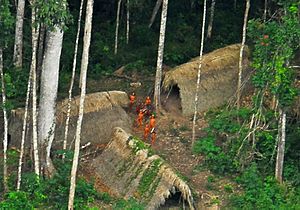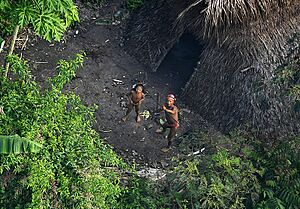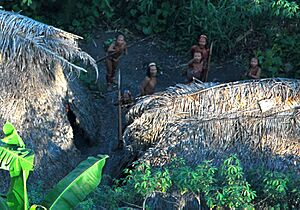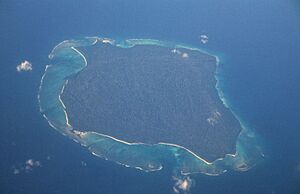Uncontacted peoples facts for kids
Uncontacted peoples are groups of indigenous peoples who live without regular contact with people from outside their own community. They are also called indigenous peoples in voluntary isolation when they choose to stay separate.
It's hard to know exactly how many uncontacted people there are. But groups like the Inter-American Commission on Human Rights and Survival International guess there are between 100 and 200 uncontacted tribes. These tribes might have up to 10,000 people in total. Most of these groups live in South America, especially in northern Brazil. Experts believe there are about 77 to 84 tribes there.
We learn about uncontacted peoples mostly from other nearby indigenous groups or from pictures taken from the air.
Contents
What Does "Uncontacted" Mean?
The term "uncontacted peoples" usually means indigenous groups who have stayed mostly separate until now. They live traditional lives and manage their own communities.
Long ago, when Europeans explored and settled new lands, most indigenous groups met outsiders. So, "uncontacted" means they don't have regular contact with the main non-indigenous society today.
The Inter-American Commission on Human Rights calls them "indigenous peoples in voluntary isolation." This means they generally choose not to have contact with anyone outside their own group. It also includes groups who once had contact but decided to go back to living separately. This shows that these groups are not "stuck in the past." They are living in the modern world, but they choose to be isolated.
A United Nations report in 2009 also talked about "peoples in initial contact." These groups are similar but are starting to talk regularly with and join the main society.
Organizations often use terms like "indigenous peoples in isolation" or "in voluntary isolation." This highlights that these groups are actively choosing to stay separate. Other names used are "hidden peoples" or "uncontacted tribes."
How They Interact with Outsiders
International groups say it's very important to protect the land and environment of indigenous peoples. It's also important to protect them from harm or unfair treatment. And, avoiding contact helps stop the spread of modern diseases, which these groups have no protection against.
In the past, many uncontacted groups were treated badly. Because of this, many governments now give them their own lands and legal protection. Many indigenous groups live in national forests or protected areas. Good examples are the Vale do Javari in Brazil or North Sentinel Island in India.
In 1961, a British explorer named Richard Mason was killed by an uncontacted Amazon tribe called the Panará. The Panará lived mostly alone until 1973. That's when a road (BR-163) was built through their land. After this, many Panará people died from new diseases. Their land was also harmed. More than 250 of the 350 Panará people died in the first year after meeting settlers.
Many arguments about uncontacted peoples happen because governments want to use the natural resources on their land. In the 1960s and 1970s, Brazil's government tried to make native groups in the Amazon join society. They wanted to use the land for farming. This didn't always work well and was criticized. So, in 1987, Brazil created a special department called the Department of Isolated Indians. It's part of Brazil's Indian Agency, called Fundação Nacional do Índio (Funai). FUNAI has helped protect lands, allowing some groups to stay mostly uncontacted.
A different story happened in Colombia with the Nukak tribe. An evangelical group contacted them. The Nukak were open to trading and later moved closer to settlers. This led to many getting sick with breathing problems, and hundreds died. More than half of the tribe was lost. The Colombian government later moved the tribe to a nearby town. They got food and help, but many lived in poverty.
The dangers faced by the Nukak tribe are common for all isolated peoples. The outside world often wants to use their land. This can include lumbering (cutting down trees), ranching, farming, looking for oil or minerals, and poaching (illegal hunting). For example, in 2007, Peru's President Alan García said uncontacted groups were just made up by environmentalists to stop oil and gas work. As recently as 2016, a Chinese mining company in Bolivia ignored signs of uncontacted tribes. They even tried to hide it. Besides businesses, other people like missionaries can also cause big problems without meaning to.
Because of these dangers, a group of Acre Indians in Brazil contacted a village and the government in 2014. This shows that many tribes know about the outside world. They choose to stay separate unless they are scared or need something. Satellite pictures suggest some tribes purposely move away from roads or logging areas to stay hidden.
Indigenous rights activists often say that isolated indigenous peoples should be left alone. They believe contact takes away their right to choose how they live. However, what happened in Brazil suggests that isolated peoples might want to trade and have good social connections. But they choose isolation because they fear conflict or being used.
Brazil's FUNAI organization, with experts, has chosen to make controlled first contact with some tribes. FUNAI has 15 trading posts in protected areas. Tribes can trade for metal tools and cooking items there. FUNAI also helps prevent conflicts and gives vaccinations. But FUNAI has said that the government doesn't give them enough money. In 2018, FUNAI shared videos and pictures of some tribes they protect. Some people criticized this. But the director, Bruno Pereira, said that the more people know, the better chance there is to protect these tribes and their lands. He explained that FUNAI was facing pressure to open up lands for businesses. He also said the photos helped investigate a possible attack on the Flecheiros tribe.
To deal with the many problems of contact, the United Nations Human Rights Council (2009) and the Inter-American Commission on Human Rights (2013) made rules. These rules include the right for groups to choose to stay isolated.
There have been reports of "human safaris" in India's Andaman Islands and in the Peruvian Amazon. Tourism companies try to help tourists see uncontacted or recently contacted peoples. This practice is very controversial.
Uncontacted Peoples Around the World
India
Sentinelese
The Sentinelese people live on North Sentinel Island in the Bay of Bengal. They refuse contact with outsiders. Attempts to reach them have often been met with force, sometimes deadly. Their language is very different from other languages in the Andamans. This suggests they have been isolated for thousands of years. Experts call them the most isolated people in the world. They will likely stay that way.
South America
Bolivia
The Toromona are an uncontacted group living near the upper Madidi River in northwestern Bolivia. The government has made a special protected area in Madidi National Park for them. In 2016, a Chinese mining company came too close to their land.
A small number of uncontacted nomadic hunter-gatherers from the Ayoreo people live in the Kaa-Iya del Gran Chaco National Park and Integrated Management Natural Area.
Pacahuaras are also thought to be living in voluntary isolation in the Pando Department.
Brazil

Before the 1970s, Brazil tried to move people off lands that could be used for business. This didn't work well. In 1987, Brazil created the Department of Isolated Indians within FUNAI. This helped protect groups. They declared the Vale do Javari a permanently protected area, covering a huge 85,444 square kilometers (33,000 sq mi). In 2007, FUNAI reported 67 uncontacted indigenous peoples in Brazil, up from 40 in 2005.
The Awá people live in the eastern Amazon rainforest. There are about 350 Awá people, and 100 of them have no contact with the outside world. They are in great danger because of conflicts with logging companies on their land.
The Kawahiva live in the north of Mato Grosso. They move around a lot and have little contact with outsiders. We know about them mostly from things they leave behind, like arrows, baskets, and hammocks.
The Korubu live in the lower Vale do Javari in the western Amazon Basin. Other tribes that might be uncontacted include the Uru-Eu-Wau-Wau and the Himarimã. There may also be uncontacted peoples in the Uru-Eu-Uaw-Uaw Indigenous Territory and Kampa Indigenous Territory and Envira River Isolated Peoples.
In 2019, some very small isolated groups got attention. Two brothers from the Piripkura tribe had lived alone in the jungle. They contacted FUNAI after a fire they had kept burning for 18 years went out. Their story was told in the documentary Piripkura. Another man, called the "Man of the Hole", lived alone on 8,000 hectares (20,000 acres). He dug many holes for farming and trapping. He was found dead in his home in August 2022.
As of 2021, uncontacted peoples in Brazil are threatened by illegal land grabbers, loggers, and gold miners. Also, the government of Jair Bolsonaro has said it wants to develop the Amazon and make indigenous protected areas smaller.
Colombia
Colombia is now seen as a country that protects uncontacted indigenous people very well. This is because they have created huge tribal reserves and patrol them strictly.
The Nukak people are nomadic hunter-gatherers. They live between the Guaviare and Inírida rivers in southeastern Colombia. Other groups, like the Carabayo, Yuri, and Passé, live in the Río Puré National Park.
Ecuador
Two isolated indigenous peoples of Ecuador live in the Amazon: the Tagaeri and the Taromenane. Both are eastern Huaorani peoples living in Yasuni National Park. These semi-nomadic people live in small groups. They get food by hunting, gathering, and growing some crops. They are organized into large families. Since 2007, Ecuador has had a national rule that says these groups should not be contacted. It also says they have the right to decide for themselves. In 2013, more than 20 Taromenane were killed by Waorani, another Huaorani group.
Paraguay
About 100 Ayoreo people, including some from the Totobiegosode tribe, live uncontacted in the forest. They are nomadic, hunting, gathering, and doing a little farming. They are the last uncontacted peoples south of the Amazon basin, living in Amotocodie. They are threatened by a lot of illegal tree cutting. According to Survival International, a Brazilian company is turning thousands of hectares of the Ayoreo-Totobiegosode tribe's old land into cattle farms. The Union of Ayoreo Natives of Paraguay is working to protect them, with help from the Iniciativa Amotocodie.
Peru
The Nomole (also called Mashco-Piro) are nomadic Arawak hunter-gatherers. They live in Manú National Park in Peru. In 1998, a group estimated their number to be around 100 to 250. They speak a dialect of the Piro languages. With outsiders coming onto their land, the tribe has made it clear they do not want contact. As of 2013, all the groups seem to be surviving. Other groups include the Machiguenga, Nanti, Asháninka, Mayoruna, Isconahua, Kapanawa, Yora, Murunahua, Chitonahua, Mastanahua, Kakataibo, and Pananujuri. Many of them speak dialects of Panoan languages. There are five protected areas for uncontacted peoples. However, the law meant to protect them does not stop businesses from operating there.
Venezuela
In Venezuela, some groups from the Hoti, Yanomami, and Piaroa tribes live mostly isolated. The Ministry of Indigenous Peoples does not have specific rules to protect these people.
Indonesia
Java
Banten is home to the Baduy or Kanekes. They are split into the Tangtu (Inner Baduy) and Panamping (Outer Baduy) or Dangka. Inner Baduy avoid all contact with outsiders. Outer Baduy have some limited contact. Dangka are the Baduy groups farthest out. They do not live in the Kanekes region and have regular contact with the outside world.
North Maluku
The O’Hongana Manyawa (Inner Tobelo or Togutil) are a semi-nomadic group living deep inside Halmahera Island. Recently, they have come into contact with nickel mining activities on the island.
Western New Guinea
Over 40 uncontacted tribes live in the West Papua region in Indonesia. However, contact usually happens when they first meet outsiders. It is hard for reporters and organizations to enter West Papua. There is no government agency specifically for protecting isolated indigenous groups. Human rights groups like Survival International say it's important to make people aware of these tribes. This can help prevent building projects near their lands. On the other hand, keeping their exact location and size a secret might help avoid encouraging contact.
Historical Examples
Australia
The Pintupi Nine lived a traditional life in the Gibson Desert of Australia until 1984. They had separated from another group of Pintupi people earlier.
United States
Ishi, a member of the Yahi people from Northern California, lived in voluntary isolation until 1911. He was known as the "last wild Indian".
See also
- Isolationism
- List of contemporary ethnic groups
- Man of the Hole
- Noble savage
- Stateless society
- Terra nullius




